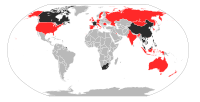
Photo from wikipedia
Introduction The risk of occupationally acquired infections among healthcare workers (HCWs) has been recognized for hundreds of years. Examples include HCWs managing patients with infections and infestations ranging from tuberculosis… Click to show full abstract
Introduction The risk of occupationally acquired infections among healthcare workers (HCWs) has been recognized for hundreds of years. Examples include HCWs managing patients with infections and infestations ranging from tuberculosis to scabies. In the past two decades, HCWs have faced an escalated threat of deadly emerging infections such as Severe Acute Respiratory Syndrome (SARS), Avian Influenza, Middle East Respiratory Syndrome (MERS) and Ebola. Methods This presentation will cover first-hand experiences gained during the SARS outbreak in 2003 in Singapore. A survey of 15,025 HCWs was conducted in Singapore during the outbreak, to study perceptions of the risk of SARS infection and work-related as well as non-work related problems faced by HCWs as a result of the outbreak. Results Worldwide, over 8,422 cases and 916 deaths were reported from 29 countries, and HCWs comprised 21% of cases. In Singapore, HCWs managed 238 cases of SARS and accounted for about 40% of the cases. A total of 10,511 HCWs in Singapore (70%) responded to the survey. There was fear of the deadly disease and HCWs faced both work as well as non-work related problems as a result of SARS outbreak. Discussion Among the insights gained during the SARS outbreak were the following: SARS was a grim reminder that health care work can be hazardous; the effects of SARS extended beyond the infection, to impact colleagues and families of HCWs; General principles for prevention and infection control were effective against SARS; and SARS posed both a public health and an occupational health threat. Given these perspectives gained and lessons learnt, we should hopefully be better prepared when faced with similar scenarios in the future.
Journal Title: Occupational and Environmental Medicine
Year Published: 2018
Link to full text (if available)
Share on Social Media: Sign Up to like & get
recommendations!